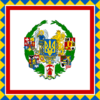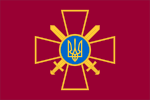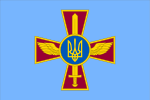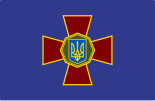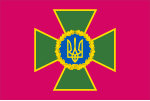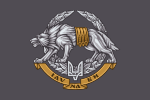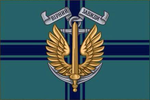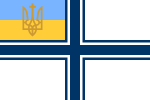Flag of Ukraine
bicolour of blue and yellow | |
| Sky-Blue Version | |
 | |
| Naval ensign | |
 | |
| Use | Naval ensign |
|---|---|
| Proportion | 2:3 |
| Adopted | 20 June 2006 |
| Design | White with a blue Saint George's cross that extends to the edges of the flag, with the national bicolour in the canton. |
The national flag of Ukraine (Ukrainian: Державний прапор України, romanized: Derzhavnyi prapor Ukrainy) consists of equally sized horizontal bands of blue and yellow.
The blue and yellow bicolor flag was first seen during the 1848 Spring of Nations in Lemberg (Lviv), the capital of the Kingdom of Galicia and Lodomeria within the Austrian Empire. It was later adopted as a state flag by the short-lived Ukrainian People's Republic, the West Ukrainian People's Republic, and the Ukrainian State following the Russian Revolution.
In March 1939, it was also adopted by
Ukraine has celebrated the Day of the National Flag on 23 August since 2004.
Design

| Scheme | Strong azure | Yellow |
|---|---|---|
| Pantone | Pantone Coated 2935 C[7] | Pantone Coated Yellow 012 C[7] |
| RAL | 5019 Azure | 1023 Gold (golden) |
| RGB color model | 0, 87, 183[9] | 255, 215, 0[10] |
CMYK
|
100, 63, 0, 2[9] | 0, 2, 100, 0[10] |
HEX
|
#0056B9 | #FFD800 |
Websafe
|
#0066cc | #ffcc00 |
There has been disagreement over the shade of blue used in the flag. Both dark blue (Ukrainian: синій) and sky blue (Ukrainian: блакитний) flags were historically used. When the flag was approved in 1992, the dark blue colour was chosen over sky blue for practical reasons: sky blue flags fade very quickly in the sun. Although the official standard was introduced in 2006, some manufacturers keep producing flags that do not match the standard.[11]
-
A Ukrainian independence poster (1917)
-
Leonid Kadenyuk at NASA, note different shades of blue on the patch and on the flag behind (1997)
-
The strip of the vehicle registration plate
The flag is similar to that of the
Protocol and use
This section needs additional citations for verification. (August 2017) |
Article 20 of the Constitution of Ukraine states that "the State Flag of Ukraine is a banner of two equally sized horizontal bands of blue and yellow colour." (Ukrainian: "Державний Прапор України — стяг із двох рівновеликих горизонтальних смуг синього і жовтого кольорів.").[12][13]

In addition to the normal horizontal format, many public buildings, such as the Verkhovna Rada, use vertical flags. Most town halls fly their town flag together with the national flag in this way; some town flags in Ukraine exist only in vertical form. The proportions of these vertical flags are not specified. When hung like a banner or draped, the blue band should be on the left. When flown from a vertical flagpole, the blue band must face the mast.
The flag did not appear on
Decoration
Traditionally, the flag may be decorated with a
Places of continuous display
Ukrainian flags are customarily displayed continuously in certain locations.
- Maidan Nezalezhnosti, main square of Kyiv, traditional site for political rallies, including large-scale radical protest campaigns (Orange Revolution and Euromaidan)
- Presidential Administration Building, Verkhovna Rada building and Government Building
- Kyiv City Council
- Lviv High Castle
- Vernadsky Research Base
- State Border Guard Service of Ukraine sites
- National, regional and local government buildings
- Ukrainian embassies and consulates
Particular days for display
The flag is hoisted up to its full staff on the following days:
- 1 January: New Year's Day
- 7 January: Christmas (Julian)
- 22 January: Ukrainian Unity and Freedom Day
- 8 March: International Women's Day
- 1 & 2 May: International Workers' Day
- 8 May: Day of Remembrance and Victory over Nazism
- 28 June: Constitution Day
- 23 August: Flag Day
- 24 August: Independence Day
- 13 October: Defenders of Ukraine Day
- 21 November: Day of Dignity and Freedom
- 6 December: Armed Forces Day
- 25 December: Christmas (Gregorian/Neo-Julian)
Display at half-staff
The flag is displayed at half-staff (or half-mast) as a sign of respect or mourning. When done nationwide, such a step is proclaimed by the president. Half-mast means flying a flag two-thirds of the way up a flagpole; the top of the flag must be at least a flag's height from the top of the flagpole. Black ribbons indicate mourning on banners that can not be lowered to half-mast.
- 4th Saturday of November: Holodomor Memorial Day
- Other historical cases: mass victims of accidents, Russo-Ukrainian War and Euromaidan; death and state funeral of Lech and Maria Kaczyński, funeral of Pope John Paul II and September 11 attacks.
Flag Day
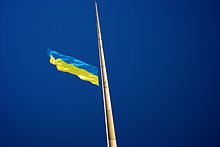
The Day of the National Flag in Ukraine is celebrated on 23 August; it began in 2004.
History
This section may contain material not related to the topic of the article. (November 2022) ) |


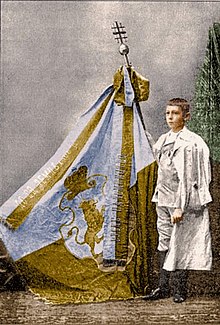
The roots of Ukrainian national symbols come from pre-Christian times when yellow and blue prevailed in traditional ceremonies, reflecting fire and water.[15] The most solid proof of yellow and blue colours can be traced back as far as the Battle of Grunwald in 1410, in which militia formations from the Ruthenian Voivodeship participated.
Blue-yellow, red-black, crimson-olive and especially raspberry colour banners were widely used by
Some put the starting point of the adoption of the current national flag of Ukraine to 1848 when, during the
During the
Early independence: 1917–1921

UPR flag with the blue and yellow flag, Ukrainian War of Independence, 1918 
1920 publication featuring Ukraine's flag and coat of arms 
Ukrainian Galician Army troops with the blue and yellow flag, 1918 Both blue-yellow and yellow-blue flags were widely used during the
demonstration.[16] On the territory of Ukraine the national flag was flown for the first time in Kyiv on 29 March 1917 by soldiers.[16] On 1 April 1917, Kyiv saw a 100,000-strong demonstration where over 320 national flags were flown.[16] Afterwards, similar demonstrations with Ukrainian flags took place across the entire Russian Empire, even beyond ethnic Ukrainian lands.[16] Numerous famous Ukrainian politicians wrote about the 1 April demonstration, including Mykhailo Hrushevsky and Serhiy Yefremov, noting that there were blue-and-yellow flags, while Dmytro Doroshenko claimed that they were yellow and blue.[16] The blue-yellow flag was flown at the First Ukrainian Military Congress on 18 May 1917.[16]The official flag established by the Ukrainian People's Republic in 1918 was blue-yellow. Instead, they refer to the decision on the Fleet Flag, which was to be light blue–yellow,[17] as an indication that the official flag was light blue–yellow.[18] Also adopted were several other service flags of the Ukrainian People's Republic.[19]
The official flag of
Symon Petlura.[citation needed] The flag of the West Ukrainian People's Republic was blue-yellow.[citation needed] The stateless Makhnovshchina, which existed during the Ukrainian War of Independence, used the black flag.[20]Among Ukrainian immigrant organisations, there were proponents of both blue-yellow and yellow-blue flags. Eventually, an agreement was reached to use the blue-yellow flag until the issue could be resolved by an independent Ukraine.
-
 Flag of the Ukrainian People's Republic (1917–1921)
Flag of the Ukrainian People's Republic (1917–1921) -
Crimean Democratic Republic(1917–1918)
-
 Flag of the Kuban People's Republic (1918–1920)
Flag of the Kuban People's Republic (1918–1920) -
 Flag of the Ukrainian State (1918)
Flag of the Ukrainian State (1918) -
 Flag of the West Ukrainian People's Republic (1918–1919)
Flag of the West Ukrainian People's Republic (1918–1919) -
Komancza Republic(1918–1919)
-
 Flag of the Lemko Republic (1918–1920)
Flag of the Lemko Republic (1918–1920) -
 Flag of the Hutsul Republic (1919)
Flag of the Hutsul Republic (1919) -
 Flag of the Kholodny Yar Republic (1919–1922)
Flag of the Kholodny Yar Republic (1919–1922) -
 Flag of the Makhnovshchina (1917-1921)
Flag of the Makhnovshchina (1917-1921)
Green UkraineSoviet Ukraine: 1922–1991
Ukrainian anthem: "Ukraine has not perished, it has not been killed yet".During Soviet rule, the Ukrainian flag was banned,
Russian SFSR. The first flag was red with the gold Cyrillic sans-serif letters У.С.С.Р. (U.S.S.R., acronym for Ukrainskaya Sotsialisticheskaya Sovetskaya Respublika in the Russian language). In the 1930s, a gold border was added to the flag. In 1937, a new flag was adopted, with a small gold hammer and sickle added above the gold Cyrillic serif У.Р.С.Р. (U.R.S.R., for Ukrainska Radianska Sotsialistychna Respublika in the Ukrainian language).-
 Red flag (1917)
Red flag (1917) -
 Flag of the Ukrainian People's Republic of Soviets (1917–1919)
Flag of the Ukrainian People's Republic of Soviets (1917–1919) -
 Flag of the Ukrainian People's Socialist Republic (1919)
Flag of the Ukrainian People's Socialist Republic (1919)
Interbellum and Reichskommissariat Ukraine
The Organisation of Ukrainian Nationalists is a Ukrainian political organisation which as a movement was originally created in 1929 in Western Ukraine (interwar Poland at the time). For a long time, the OUN did not officially have its own flag; however, during the Hungarian and Polish aggression against the
Republic of Carpathian Ukrainein 1939, Carpathian Sich, a militarised wing of the OUN, adopted as its flag a design taken from the OUN's emblem – a golden nationalistic trident on a blue background. The flag was finalised and only officially adopted by the organisation in 1964 at the 5th Assembly of Ukrainian Nationalists.The Ukrainian Insurgent Army was a Ukrainian nationalist paramilitary and later partisan army that engaged in a series of guerrilla conflicts during World War II against Nazi Germany, the Soviet Union, Czechoslovakia, and both underground and communist Poland. The group was the military wing of the Organisation of Ukrainian Nationalists — Bandera faction (the OUN-B), originally formed in Volyn in the spring and summer of 1943. Its official date of creation is 14 October 1942. The battle flag of the UPA was a 2:3 ratio red-and-black banner. The flag continues to be a symbol of the Ukrainian nationalist movement. The colours of the flag symbolise 'Ukrainian red blood spilled on Ukrainian black earth'.
-
Flag of the Ukrainian Insurgent Army and Organisation of Ukrainian Nationalists (Bandera faction)
-
Ukrainian National Government
In 1949, the flag of the Soviet Ukraine was changed once again.[24] The Soviet Union managed to obtain two additional seats in the United Nations by adding Ukraine and Byelorussia as member states.[24] The flag change came about because all the Soviet flags were the same.[24] The new Ukrainian flag consisted of red (top, 2/3) and azure (bottom, 1/3) stripes,[24] with the golden star, hammer and sickle in the top left corner. Communist party leaders such as Nikita Khrushchev and Lazar Kaganovich feared using words like 'light blue' and 'blue' in the official flag colours, as they were the terms used by the Ukrainian diaspora.[24]
During the Soviet period, multiple unsanctioned attempts to hoist the national blue-and-yellow flag were made. In 1958, an underground group was established in the village of Verbytsia, Khodoriv Raion; its members raised national flags and spread anti-Soviet pamphlets under cover of darkness.[25]
Return of the national flag
The Ukrainian national flag was raised outside Kyiv's City Hall for the first time on 24 July 1990. Under the influence of
Supreme Soviet of the Lithuanian SSR re-established Lithuania's national flag and coat of arms as the state symbol. The parliaments of Latvia and Estoniasoon followed suit.The events in the Baltic countries soon led to similar patterns in Ukraine. In particular, West Ukraine and the Ukrainian SSR's capital city of Kyiv were the scenes of near-constant political demonstrations, in which yellow-and-blue flags were waved by demonstrators.
- On 14 March 1990, the Ukrainian flag was raised for the first time since the establishment of the Soviet Union in the small city of Stryi.[26]
- On 20 March 1990, the Shche ne vmerla Ukrainy national anthem. The same day, the yellow-and-blue national flag was flown for the first time in 80 years on a governmental building in Kyiv, replacing the then-official red-azure flagof the Ukrainian SSR.
- On 28 April 1990, the Lviv oblast council (oblasna rada) also allowed the use of the national symbols of Ukraine within the Oblast.
- On 29 April 1990, the yellow-and-blue flag was flown from the Ternopil city theatre's flagstaff without the flag of the Soviet Union hanging above it.
- After 24 July 1990, the yellow-and-blue flag was flown for the first time over an official governmental building, the Kyiv City Council, on Maidan Nezalezhnosti Square of Khreshchatyk Street.[27]
- After the declaration of independence of Ukraine on 24 August 1991, the national yellow-and-blue flag flew for the first time over the Ukrainian Parliament (Verkhovna Rada) building on 4 September 1991.
The blue and yellow flag was provisionally adopted for official ceremonies in August 1991 following
2022 Russian invasion of Ukraine, landmarks all over the world were lit up with the colours of the Ukrainian flag, while numerous cities raised the Ukrainian flag in solidarity.[30][31] Kastuś Kalinoŭski Regiment, an independent Belarusianvolunteer regiment, also adopted the colours of the Ukrainian flag in its insignia.Controversies and criticism
Origin
One claimed version is that, since one of the first known coloured depictions of the
Mazepa fought under yellow-blue banners, while their Swedish allies were under yellow ones. Some Cossacks and noblemen had coats of arms in yellow and blue.[32]Yellow-blue versus blue-yellow
Ukrainians commonly refer to the flag as "yellow and light blue" (Ukrainian: жовто-блакитний, zhovto-blakytnyi) river.
The head of the Ukrainian Heraldry Society, Andriy Grechylo, points to the fact that the discussion about order of colours was taking place as far back as 1918.[24] Nonetheless, both governments of the Ukrainian People's Republic as well as the Ukrainian State defined that the upper half would be light-blue, while the lower would be yellow.[24] During 1918 it was taken into consideration that light blue would lose its shade under sun, therefore it was decided to make the colour darker.[24]
Already in the 1918 draft of the Constitution of the Ukrainian People's Republic, the order of colours was defined as blue and yellow.
Republic of Carpathian Ukraine on 15 March 1939.[24] The argument on the order of colours was taking place in the Ukrainian diaspora as well.[24] In 1949 it was decided that, until Ukraine defined a single state flag, the diaspora would use the blue-and-yellow banner.[24]Attempts to revive Soviet flags
On 21 April 2011, the Verkhovna Rada passed a law allowing the Victory Banner to be raised on Victory Day.[34] The current Victory Banner was adopted in Russia in 2007. On 20 May 2011, the law was signed by the President of Ukraine Viktor Yanukovych.[35] On 17 June 2011, the Constitutional Court of Ukraine recognised the law as unconstitutional and proposed that the parliament implement required amendments to the Constitution of Ukraine.[36]
On 9 April 2015, the Ukrainian parliament passed legislation on
totalitarian regimes".[37] Since then, Soviet symbols, like the Victory Banner, have only been allowed in cemeteries.[38][39]Soviet flags have been flown in territories
invaded the country in 2022.[40]Flag of the head of state
Throughout the history of
flag of the president of Ukraine, was adopted in 1999. In 2022, the president of Ukraine used a variant where the left side of the blue upper-half contains the yellow Tryzub.[41]-
 Standard of the President of the Ukrainian People's Republic in exile
Standard of the President of the Ukrainian People's Republic in exile
Military flags

Navy and National Guard flags being flown during a military parade -
Armed Forces
-
Ground Forces
-
Air Force
-
National Guard
-
Navy
-
Special Operations Forces
Historical
Soviet Union-
 Flag of the Soviet Union used to represent the Soviet Army (1955–1991)
Flag of the Soviet Union used to represent the Soviet Army (1955–1991) -
Soviet Air Force(1924–1991)
-
Soviet Airborne Troops
-
 Flag of the Soviet Navy (1953–1991)
Flag of the Soviet Navy (1953–1991)
See also
- List of Ukrainian flags
- Flags of the regions of Ukraine
- Coat of arms of Ukraine
- National colours of Ukraine
References
- ^ a b Signing the Agreement to eliminate the USSR and establish the Commonwealth of Independent States.
- ^ a b "Figure Skating Drama - Part 2 - The Lillehammer 1994 Olympic Film". youtube.com.
- ^ a b "Церемонія підняття Прапора України у місті Львові". youtube.com (in Ukrainian). 23 August 2016.
- ^ a b "Урочиста церемонія підняття Державного Прапора України 23.08.17". youtube.com (in Ukrainian). 23 August 2017.
- ^ a b "ДЕРЖАВНИЙ ПРАПОР УКРАЇНИ ПІДНЯТО У ЛЬВОВІ". youtube.com (in Ukrainian). 23 August 2019.
- ^ a b "У Вінниці підняли найбільший в області Державний прапор України". youtube.com (in Ukrainian). 23 August 2021.
- ^ a b c Kuzemska, N. (2006). "ДСТУ 4512:2006. Державний прапор України. Загальні технічні умови" [DSTU 4512:2006. National flag of Ukraine. General technical conditions]. uk.wikisource.org (in Ukrainian). Research Institute of Design of NAU, Ukrainian Research Institute of Textile Industry. Retrieved 9 March 2022.
- ^ "Про затвердження Порядку виготовлення Державного Прапора України" [On the Approval of the Rules for the Production of the State Flag of Ukraine] (in Ukrainian). Verkhovna Rada of Ukraine. 20 October 2021. Retrieved 3 March 2024.
- ^ a b "PANTONE® 2935 C - Find a Pantone Color | Quick Online Color Tool | Pantone". www.pantone.com. Archived from the original on 15 July 2021. Retrieved 4 June 2020.
- ^ a b "PANTONE® Yellow 012 C - Find a Pantone Color | Quick Online Color Tool | Pantone". www.pantone.com. Archived from the original on 26 May 2019. Retrieved 4 June 2020.
- ^ Martynnyk, Bohdanna (23 August 2020). "Як комуністи ледь не зіпсували наш синьо-жовтий стяг - Спецтема" (in Ukrainian). Ekspres. Retrieved 3 March 2024.
- ^ Constitution of Ukraine.
- ^ Конституція України. Верховна Рада України (in Ukrainian).
- 1+1(August 23, 2011)
- ^ Saprykov, V. (30 May 2003). Флаг Украины [Flag of Ukraine]. geraldika.ru (in Russian). Retrieved 2 October 2017.
- ^ Ukrayinska PravdaІсторична правда. 14 January 2014. Retrieved 4 March 2022.
- ISSN 0130-5247. Archived from the original(PDF) on 5 July 2007.
- ^ Chmyr, Mykola (2006). Українське військо у ХХ-ХХІ сторіччі: 'Командні хоругви' Галицької Армії (серпень 1919 р.) [Ukrainian Army in the 20th-21st Century: 'Command banners' of the Galician Army (August 1919)]. vijsko.milua.org (in Ukrainian). Archived from the original on 4 July 2007. Retrieved 2 October 2017.
- ISBN 978-966-02-5259-2
- OCLC 1225942343.
- ^ Smith, Ned (24 February 2001). "Green Ukraine / Ukrainian Far East (1921, Russian Far East)". FOTW "Flags Of The World". CRW Flags. Retrieved 24 October 2018.
In "Flags of Non-Russian Peoples Under Soviet Rule" by Prof. Walter Trembicky [tbc69], pages 134 and 135, it mentions two proposed flags for Green Ukraine, or the Ukrainian Far East, neither of which was officially adopted, since the movement quickly proved abortive. There are simple black & white line drawings illustrating the two proposed flags on p. 133 of [tbc69]. The green in the two flags was described as dark or deep green. ... One [of the two proposed flags] was the Ukrainian blue-over-gold bicolor with a green triangle at the hoist.
- ^ Trembicky, Walter (1969). Flags of Non-Russian Peoples Under Soviet Rule. Flag Research Center. pp. 134, 135.
- ^ "The Revolution On Granite: Ukraine's 'First Maidan'". Radio Free Europe/Radio Liberty. Retrieved 4 March 2022.
- ^ a b c d e f g h i j k l Gazeta.ua (23 August 2013). "Хрущов і Каганович боялися слова "жовто-блакитний" (Khrushchev and Kaganovich were afraid of the word "zhovto-blakytnyi")". Gazeta.ua (in Ukrainian). Retrieved 4 March 2022.
- Ukrayinska PravdaІсторична правда. 29 July 2011. Retrieved 4 March 2022.
- ^ "History of evolution of the State Flag of Ukraine". Ukrinform (in Ukrainian). 23 August 2015. Retrieved 4 March 2022. "Укрінформ - актуальні новини України та світу". Archived from the original on 17 August 2015. Retrieved 23 August 2015.
{{cite web}}: CS1 maint: bot: original URL status unknown (link) - ^ "22 роки тому в Києві офіційно підняли синьо-жовтий прапор (Twenty two years ago in Kyiv officially was raised the blue-yellow flag)". BBC News Україна (in Ukrainian). 24 July 2012. Retrieved 4 March 2022.
- UNIAN. Retrieved 4 March 2022.
- ^ Trach, Nataliya (26 August 2016). "The story behind 2 top Ukrainian symbols: National flag and trident". Kyiv Post. Retrieved 27 August 2016.
- ^ "Town of Blue Mountains Info:Town Raises Ukrainian Flag in Support and Solidarity for the People of Ukraine". Archived from the original on 11 April 2022. Retrieved 18 March 2022.
- ^ "VIDEO : Ukraine invasion: Europe's landmarks turned blue and yellow in solidarity with Kyiv". 25 February 2022.
- ^ Vannier, Alexis (24 August 2021). "" CHTCHE NE VMERLA UKRAÏNY " : HISTOIRE DU DRAPEAU DE L'UKRAINE". taurillon.org (in French). Retrieved 16 March 2022.
- ^ A little less often they use also "yellow and blue", "blue and yellow" and "yellow and azure".
- Ukrayinska PravdaІсторична правда (in Ukrainian). 21 April 2011. Retrieved 4 March 2022.
- Ukrayinska PravdaІсторична правда (in Ukrainian). 21 May 2011. Retrieved 4 March 2022.
- ^ "КС Украины признал неконституционным использование красного знамени Победы (CC of Ukraine recognised the use of Red Victory Banner as non-constitutional)". Russian Gazette Российская газета (in Russian). 17 June 2011. Retrieved 4 March 2022.
- ^ Peterson, Nolan (10 April 2015). "Ukraine Purges Symbols of Its Communist Past". Newsweek. Retrieved 17 May 2015.
"Rada bans Communist, Nazi propaganda in Ukraine". Interfax-Ukraine. 9 April 2015. Retrieved 17 May 2015.
Hyde, Lily (20 April 2015). "Ukraine to rewrite Soviet history with controversial 'decommunisation' laws". The Guardian. Archived from the original on 16 May 2015. Retrieved 17 May 2015. - ^ Shevchenko, Vitaly (14 April 2015). "Goodbye, Lenin: Ukraine moves to ban communist symbols". BBC News. Retrieved 17 May 2015.
- ^ "Ukraine lawmakers ban 'Communist and Nazi propaganda'". Deutsche Welle. 9 April 2015. Archived from the original on 1 October 2015. Retrieved 11 February 2023.
- ^ Young, Pareisa (11 March 2022). "Ukraine: Russian troops flying Soviet flag, symbol of 're-establishing Russian domination'". The Observers - France 24. Archived from the original on 27 April 2022. Retrieved 4 May 2022.
- ^ Basu, Zachary (1 March 2022). "Zelensky tells European Parliament "nobody is going to break us" in emotional appeal". Axios. Retrieved 4 March 2022.
External links
 Wikimedia Commons has media related to National flag of Ukraine.
Wikimedia Commons has media related to National flag of Ukraine. Wikiquote has quotations related to Flag of Ukraine.
Wikiquote has quotations related to Flag of Ukraine.- Ukraine at Flags of the World
- DSTU 4512:2006 Technical specifications from DSTU (Ukrainian national standards body) regarding flag of Ukraine, in Ukrainian. 1 September 2006.
- Ukraine – Vexillographia
- Armed Forces Flag in Ukraine
- Departmantal Flag and Emblem in Ukraine
- Brief history of the flag Archived 18 December 2011 at the Wayback Machine at the Science Library of Franko National University (Lviv).
- "About Ukrainian flag". Statement of the Presidium of the Supreme Council of Ukraine. 18 September 1991.
- "About the State Flag of Ukraine". State of the Supreme Council of Ukraine. 28 January 1992.
-











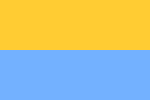


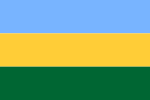
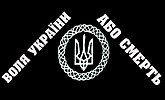

![Version of the flag of the Ukrainian Far Eastern Republic (1917–1922) in Siberia[21][22]](http://upload.wikimedia.org/wikipedia/commons/thumb/9/96/Flag_of_Green_Ukraine.svg/150px-Flag_of_Green_Ukraine.svg.png)
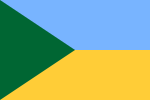

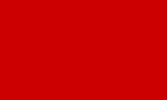
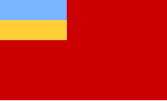
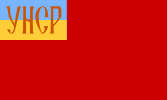







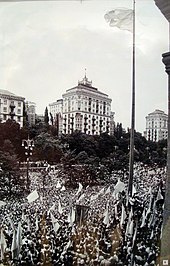



![Flag of Ukraine with lighter shades is non-standard but has been frequently used[1][2][3][4][5][6]](http://upload.wikimedia.org/wikipedia/commons/thumb/a/a7/Flag_of_Ukraine_%28fair_blue%29.svg/150px-Flag_of_Ukraine_%28fair_blue%29.svg.png)

